

William Stopford
The cars axed in 2025 that we'll miss the most
15 Hours Ago
The Sportage is one of the few vehicles in the segment that offers the base trim level with a flagship powertrain – is it a top value pick?
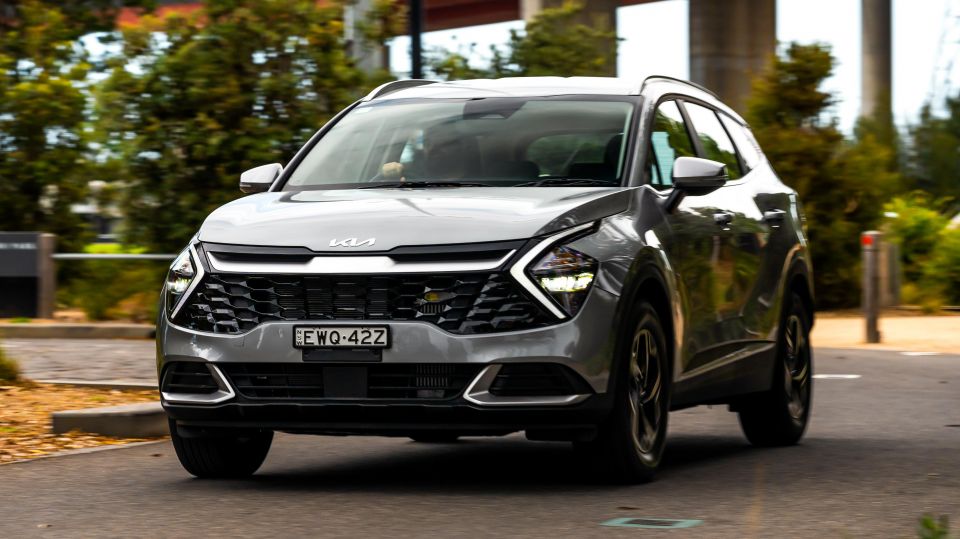
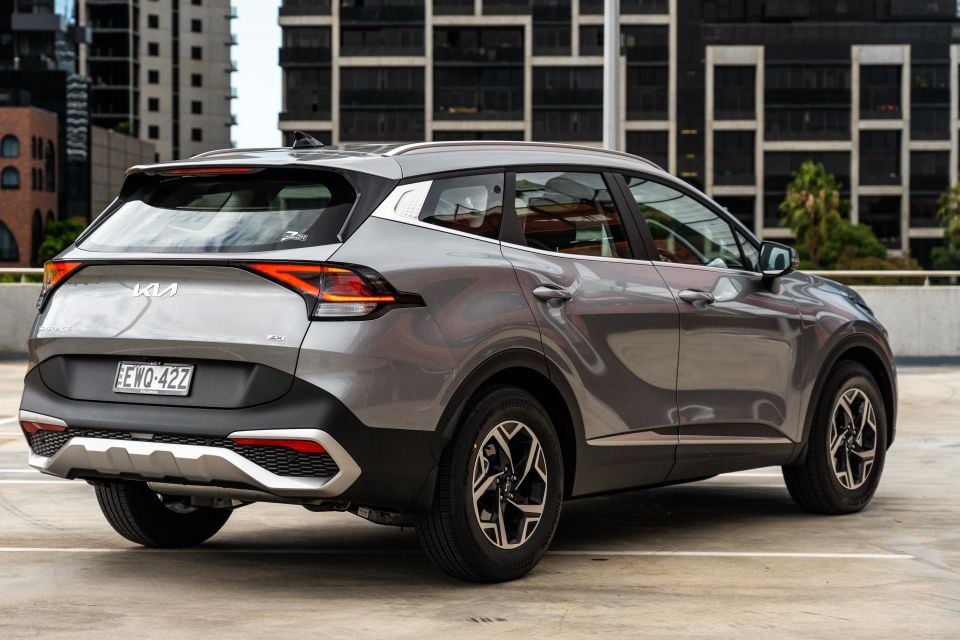

Quickly see how this car stacks up against its competition. Select any benchmark to see more details.
Where expert car reviews meet expert car buying – CarExpert gives you trusted advice, personalised service and real savings on your next new car.
The latest Kia Sportage is one of the key reasons the Korean brand cracked Australia’s top three brands in 2022.

While already one of Kia’s more popular nameplates locally, the fifth-generation Sportage was far and away the brand’s top seller last year, contributing 18,792 units out of the brand’s 78,330 registrations for the 2022 calendar year.
That yearly figure represents a massive 136.4 per cent growth on 2021’s result, despite Kia battling crippling supply shortages of its popular mid-sizer for the bulk of 2022. It’s been hit even harder in 2023, though that doesn’t make the Toyota RAV4 and Mazda CX-5 fighter any less important in the line-up.
For 2023 the line-up is much the same with some minor price adjustments, as has been in vogue for much of the last 12-18 months. At least with the Sportage, it’s limited to a few hundred bucks.
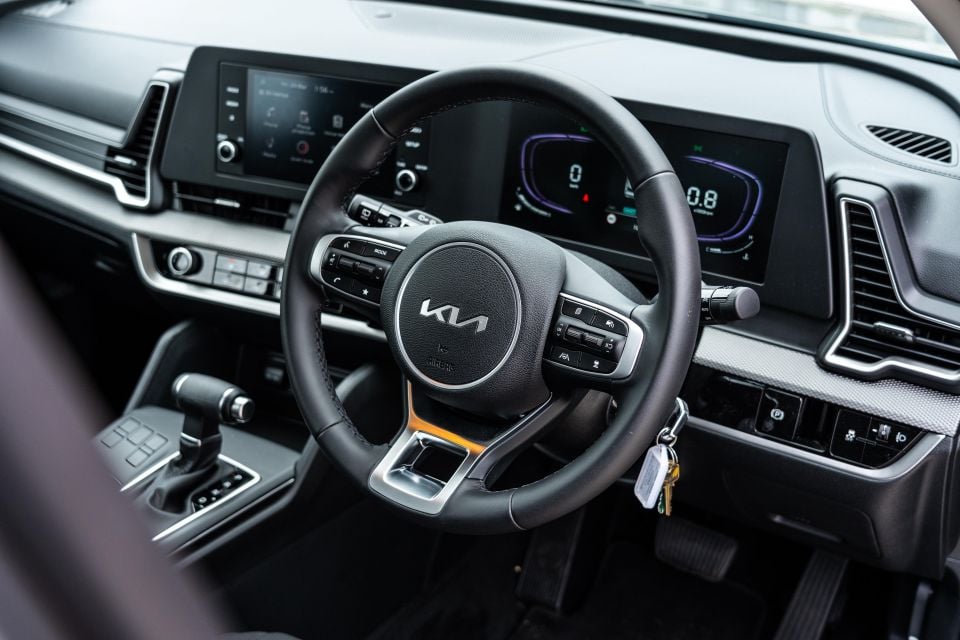
Here on test we have the 2023 Kia Sportage S 2.0D AWD, which combines the entry-level trim with what is currently the flagship powertrain in the line-up – at least until the Sportage Hybrid arrives in 2024.
At $40,000 plus on-roads it’s more in line with mid-spec rivals in the segment, though the Sportage even in base trim packs a lot of space, features and refinement for the money. Is it a top pick like its higher-grade siblings?
Pricing for the Sportage S starts from $32,795 plus on-road costs for the base 2.0 FWD manual, with the 2.0D AWD on test listing for $40,195 before on-roads.
The 2.0D AWD commands more than $6000 over its 2.0 FWD counterpart with the automatic, which is quite a price to pay – it’s almost as much as the penultimate SX+ trim level with the base 2.0 FWD powertrain.
If you want more kit, the step up to the SX 2.0D is just over $2500, with the SX+ 2.0D $7000 dearer than the base grade. The flagship GT-Line is over $12,000 more than the equivalent Sportage S.
Key rivals for this base diesel Sportage include the Hyundai Tucson Elite 2.0D AWD ($46,150) and Mazda CX-5 D35 Touring Active AWD ($47,600). For equivalent fuel economy without the diesel element, there are petrol-electric hybrid alternatives like the GWM Haval H6 Lux Hybrid ($42,490 D/A) and Toyota RAV4 GX AWD Hybrid ($45,260).
It’s worth noting the Tucson and CX-5 don’t offer a diesel in their respective base trim levels that would be equivalent to the Sportage S grade on test. The GWM Haval H6 Lux Hybrid is based on the mid-spec trim level, while the RAV4 GX is the closest in terms of trim and specification, being the base grade.
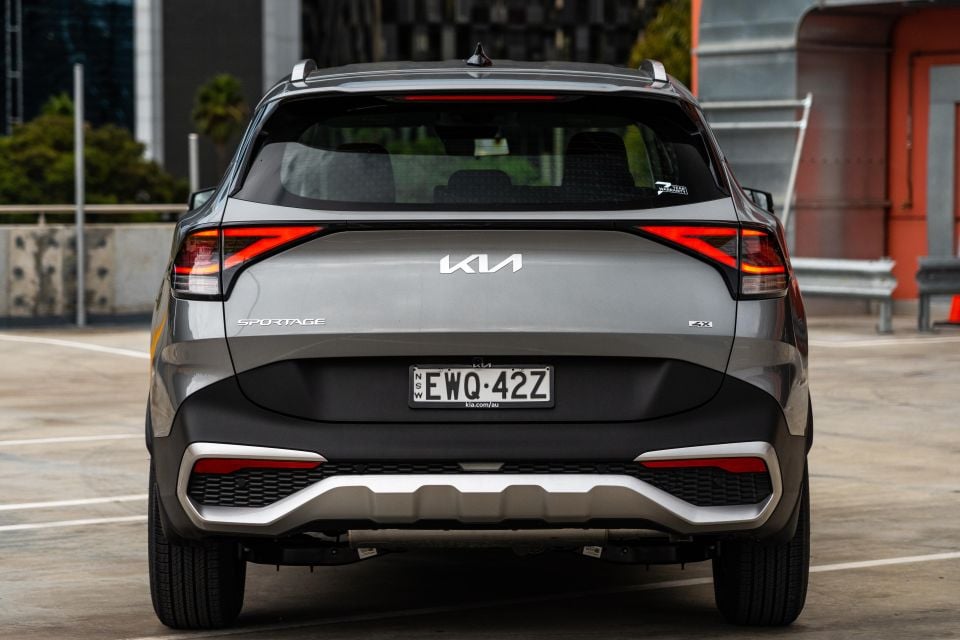
2023 Kia Sportage pricing:
Smartstream G2.0 FWD
Smartstream G1.6 T-GDI AWD
Smartstream D2.0 AWD
Prices exclude on-road costs
Buy your new car without the stress. It's fast, simple and completely free.

Great service from Travis and team, second time I have used this business would not hesitate to recommend them to anyone
Craig C.
Purchased a Ford Ranger in Sunshine Coast, QLD
CarExpert helped Craig save thousands on his Ford Ranger, now let us save you on your next new car.
Find a dealWhere the GT-Line is dominated by screens and leather, the S is a far more basic, almost fleet-spec take.

The bones of the higher-spec grades is here, if with less glossy bits and harder plastics throughout – yes, the doors and armrests aren’t even padded here, unlike other variants in the range.
You get a big ol’ T-bar shifter instead of the more techy shift-by-wire rotary selector in the flagship GT-Line, and there’s even a key barrel ignition instead of push-button start – #firstworldproblems, but it’s a rarity these days.
Cloth trim adorns the seats and while basic in design it’s hardy yet supple and doesn’t feel cheaply manufactured, while the other touchpoints like the leather-appointed steering wheel and padded front-centre armrest elevate the cabin’s ambience a bit.
You’ll also notice a lot of blanked buttons on the centre console which is a reminder you’ve gone for the base specification, and the S is the only local Sportage variant that gets an 8.0-inch touchscreen infotainment system and no touch-based control bar for the media and climate control systems.
The driver gets manual adjustment for the seat and steering wheel, as you’d expect, and while the appointments are basic, adjustment is broad and it’s quite easy to find a comfortable driving position.
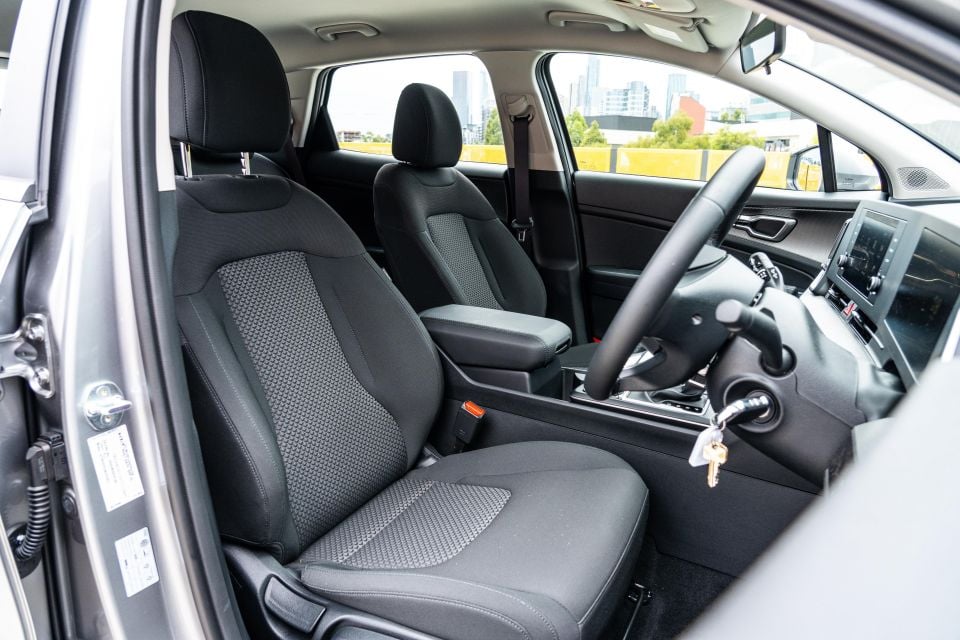

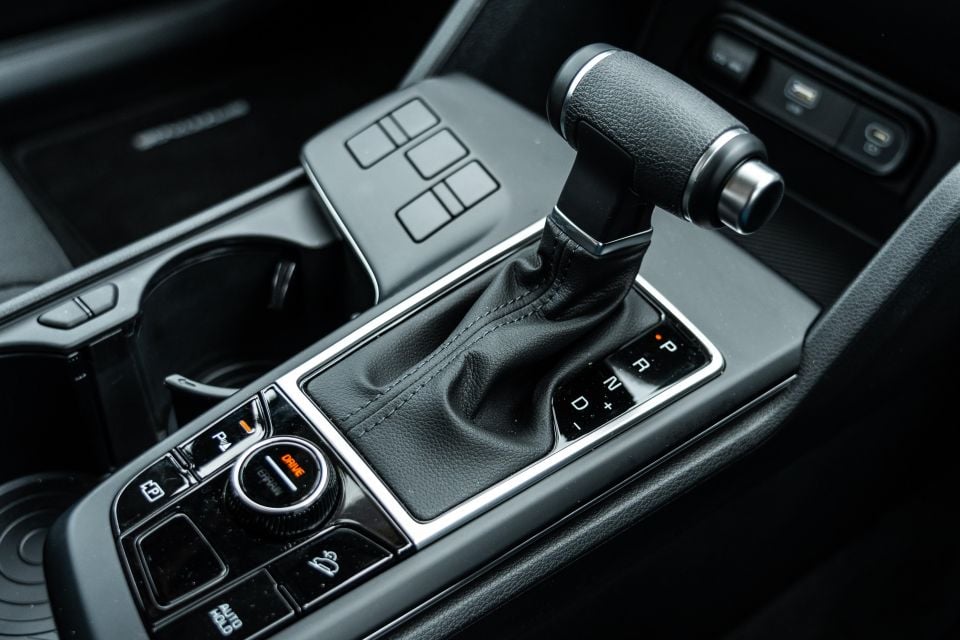
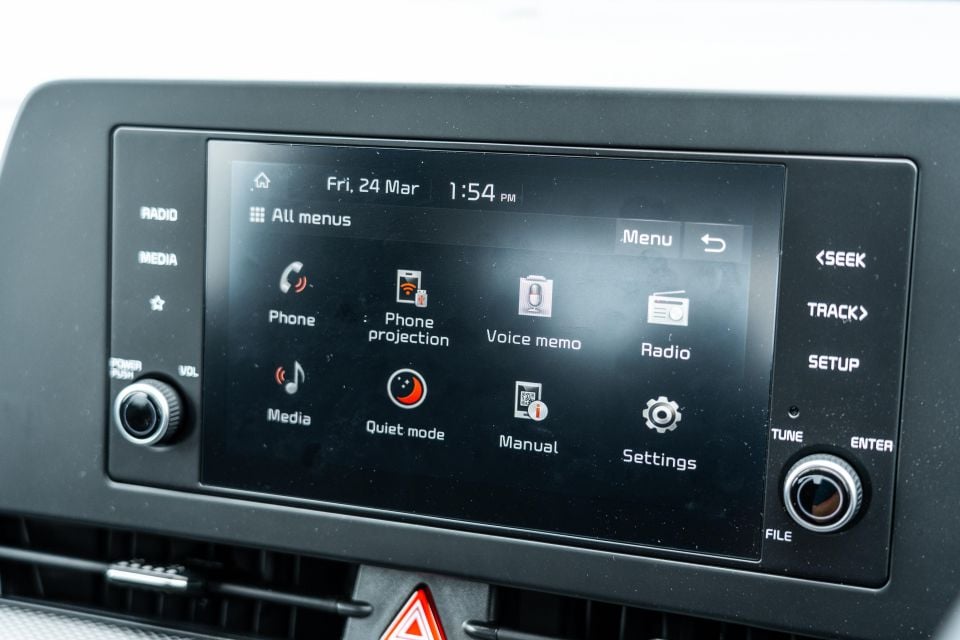
Behind the steering wheel is the ‘Basic’ digital instrument cluster that features in the S, SX and SX+. It’s simply a 4.2-inch TFT supervision display flanked by clock radio-style tacho and speedo readouts. It’s fine, but is a little basic and cheap-looking especially compared to the 12.3-inch digital cluster found on the GT-Line.
The central touchscreen is similarly basic. It offers wireless Apple CarPlay and Android Auto, in addition to DAB radio, but there’s no native satellite navigation and it’s running an older interface that is neither as clean nor as responsive as the system in higher grades.
I also had numerous issues with my phone connection dropping out and failing to reconnect, which was extremely frustrating when navigating using app-based mapping or mid-phone call. Thankfully when it did work, audio quality was clear for a base system.
The better 12.3-inch touchscreen available from the SX and up would be one of the main things that would prompt me to spend the extra $2500 for the grade above.
Otherwise storage is pretty impressive for the class, with a big, modular centre console, a deep centre bin, a cubby ahead of the shifter and average-sized door pockets – something about this Hyundai/Kia platform means you can’t fit bigger bottles in the doors…
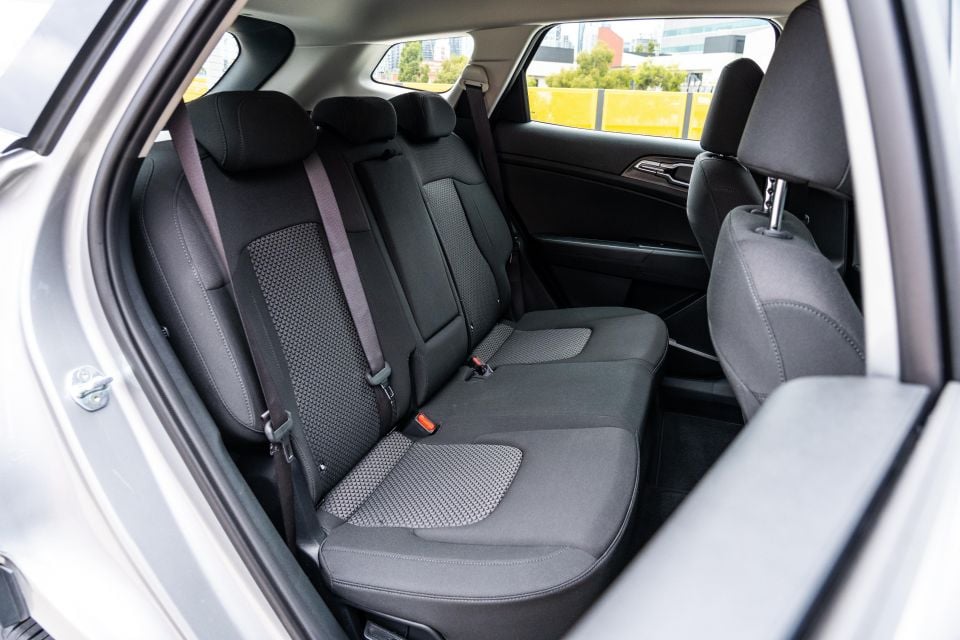

Australia gets the long-wheelbase Sportage rather than the shorter body available in Europe, and compared to the previous-generation model that has translated to a welcome bump in rear seat space and boot space.
The Sportage has gone from being one of the more compact vehicles in the class to one of the largest, and that no doubt has helped the Kia find favour amongst Australian families.
I’m 6’1 and have plenty of head-, knee- and toe room behind my preferred driving position, while the wide body and relatively flat bench and floor means you could seat three across in decent comfort.
Kids are catered for with outboard ISOFIX anchors and top-tether points across all three rear seats, while amenities include directional rear air vents, a fold-down armrest with cupholders, rear map pockets and small bottle holders in the doors
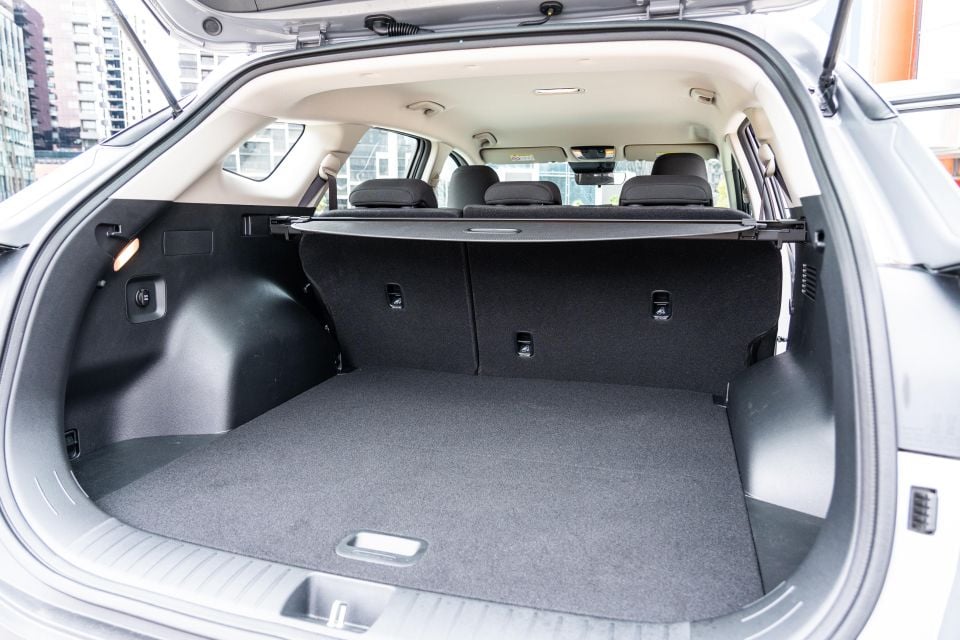

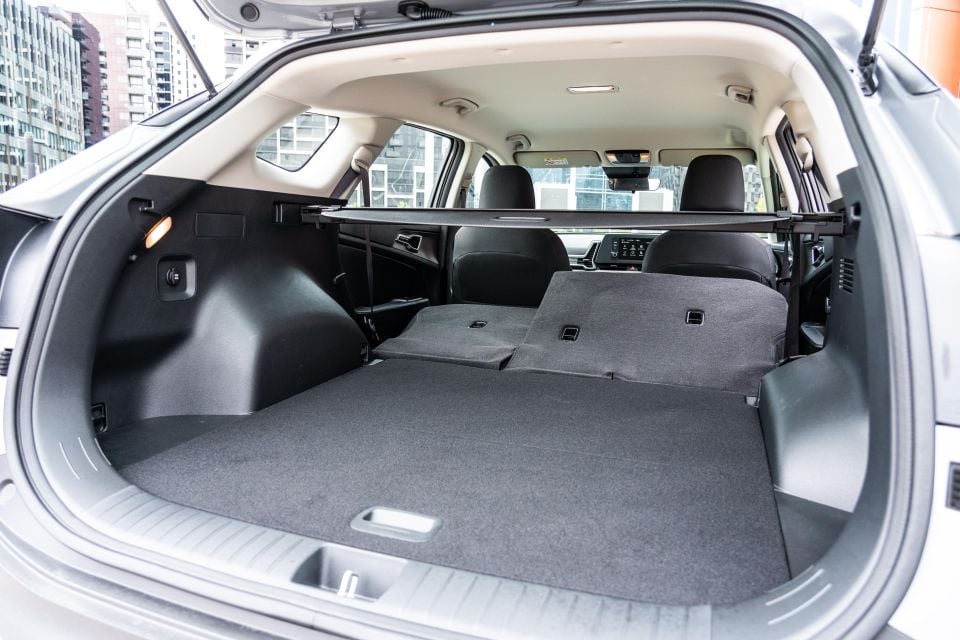
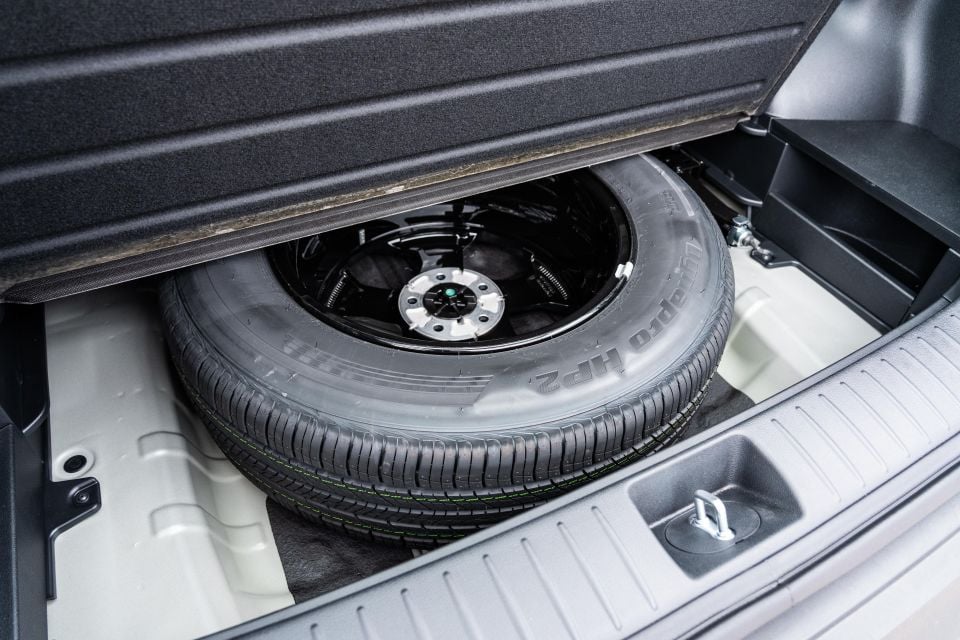
At 543 litres (VDA) with all seats in use, the Sportage’s boot is among the largest in segment. Drop the rear seats and you get a big ol’ 1829L (VDA).
That’s more than both the Tucson (539L) and CR-V (522L), and matches the RAV4 (542L). It’s also about 80L more than the previous generation Sportage in five-seat layout.
Other highlights a 12-volt outlet and a full-sized alloy spare wheel under the floor.
Diesel versions of the Kia Sportage are powered by a 2.0-litre four-cylinder turbo-diesel, dubbed Smartstream D2.0.

Quoted outputs are 137kW (4000rpm) and 416Nm (2000-2750rpm), which are healthily above the 115kW/192Nm offered by the base 2.0-litre naturally aspirated petrol (Smartstream G2.0).
The diesel comes as standard with on-demand all-wheel drive and an eight-speed automatic transmission. It’s worth noting the base Smartstream G2.0 gets a six-speed auto with front-wheel drive, while the mid-tier Smartsteam G1.6 T-GDI gets a seven-speed dual-clutch auto with all-wheel drive – the diesel is easily our pick if you can afford it.
Combined fuel consumption is rated at a thrifty 6.3 litres per 100km, with CO2 emissions of 163g/km. There’s also a diesel particulate filter (DPF). All versions of the Kia Sportage are fitted with a 54-litre fuel tank.
If you’re looking to tow light loads the Sportage 2.0D is arguably the most capable in the range, quoting a maximum braked towing capacity of 1900kg with a 100kg max towball download. The only other variant in the range that can match that max tow capacity is the Sportage 2.0 FWD manual (S, SX) which quotes the same figures.
I know a lot of people are moving away from diesels these days in favour of hybrids and EVs, but I still feel there’s a place for oilers in passenger and SUV segments.
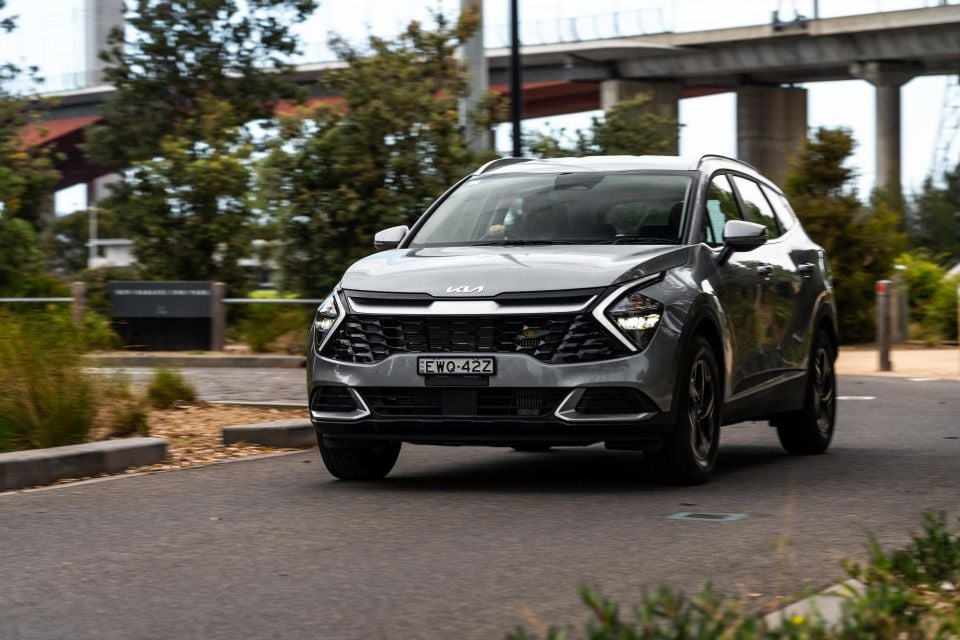
The Sportage 2.0D is a prime example, in how it offers effortless, reasonably refined performance with excellent real-world fuel economy – especially when compared to the 2.0 FWD and 1.6T AWD drivetrains also offered.
Our base S tester doesn’t even have keyless start, so after turning the key barrel ignition the 2.0-litre diesel fires up with a muted grumble. There’s a bit of clatter particularly at a cold idle, but it’s nothing like most dual-cab utes.
Setting off you’ll notice the Sportage 2.0D has a more relaxed feel than its beefier outputs might suggest, with the eight-speed automatic preferring to lean on that wave of low-down torque rather than revving out to the redline.
Drive with a measured right foot, and the Sportage 2.0D gets along effortlessly with minimal fuss, shifting snappily through its eight cogs with a focus on efficiency and smoothness rather than outright performance in normal driving.
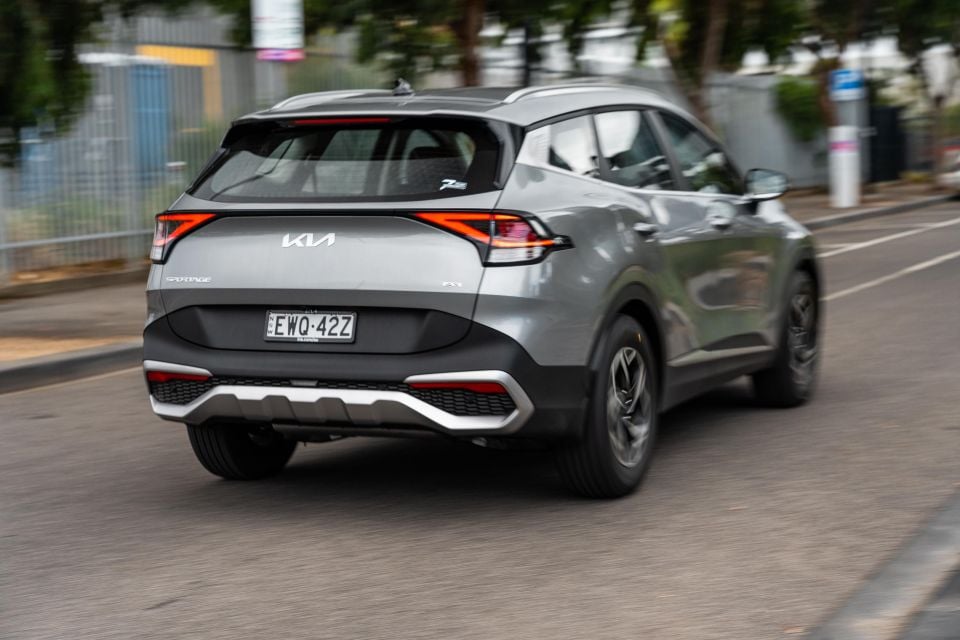
Under acceleration the engine remains fairly refined with a rumbly note that mutes the diesel clatter, and if you really plant it the oiler will respond with pretty muscular acceleration. Overtaking in this will be a breeze, as it gets along quite nicely if you hustle it while already rolling.
While diesels are better suited for the open road, the Sportage 2.0D happily putts around town without feeling laggy. The lack of idle stop/start tech means you will hear it rumble at idle if you’re stopped at the lights or school drop-off, however.
The steering is lighter in weight but is accurate and offers good feedback, meaning you can pilot the Kia in tight streets with confidence as well as on the open road, where it settles nicely and has quite a planted feel.
Diesel versions are about 220kg heftier than the equivalent 2.0 FWD petrol, so at times the Sportage can feel more like a Sorento in size and vibe in the sense it has that big-car feel on the road and through the controls.

I spent plenty of time commuting to and from the CarExpert Melbourne office in heavy traffic as well as on the freeway, and I really enjoyed how unfazed the diesel-powered Sportage was in every scenario. It’s quite capable across the board, hence why I normally would recommend the diesel as my top pick of the powertrain line-up.
Kia has still made an effort to make the Sportage handle with a bit of verve, with that accurate steering feel mentioned earlier translating to a reasonably responsive front end teamed with a well balanced chassis that doesn’t fall over in bends but also doesn’t compromise comfort – especially on the S’s smaller 17-inch alloy wheels shod in chubby 235/65 tyres.
The diesel’s more effortless character, though, makes this more of a cruiser than a more sporting crossover. If you’re looking for the most engaging mid-size SUV to drive, I’d be taking a look at something like the Cupra Formentor or Mazda CX-5.
Remember that Kia Australia has an extensive local ride and handling program that tailors its new products to our roads, and like other models in the company’s stable the Sportage feels very well suited to local roads and conditions.
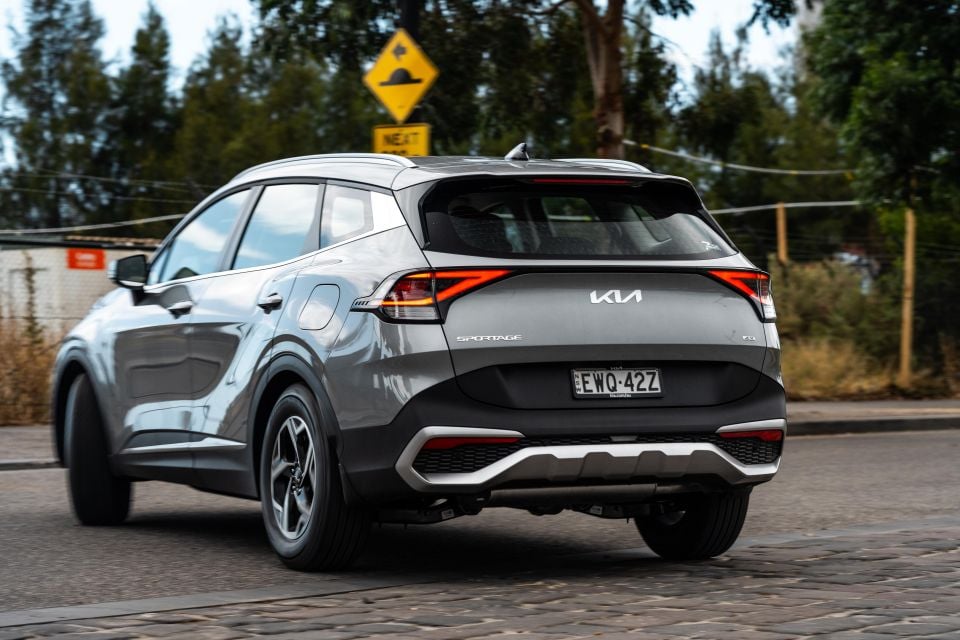
Where the Sportage 2.0D really comes into its own is on the freeway, where it happily hums away in eighth gear well under 2000rpm.
The cabin is well insulated from engine, wind, and road noise, with high-speed ride compliance again proving to be at the higher end of the class, even without the help of adaptive damping offered by some rivals.
Again that big car feel lends confidence at high speeds and adverse weather conditions, and the active all-wheel drive system also keeps the Sportage secure when things get wet, muddy or gravelly. There’s never any axle tramp or wheel slip under hard acceleration – it just goes, and with more shove than its petrol siblings could ever muster.
Save for the fleet-spec interior appointments, the base Sportage 2.0D has quite the upmarket feel on the move.
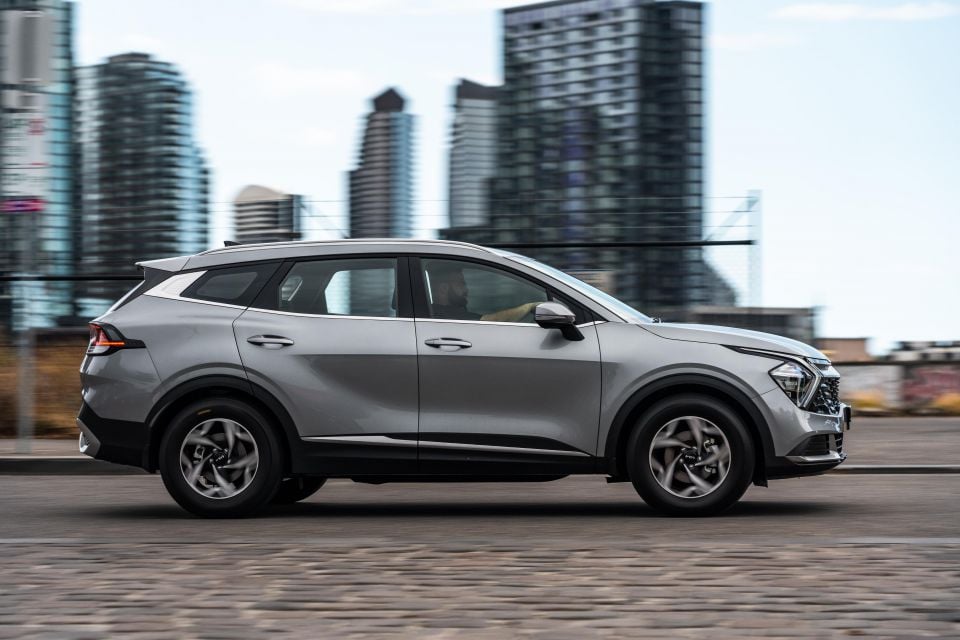
Where expert car reviews meet expert car buying – CarExpert gives you trusted advice, personalised service and real savings on your next new car.
As for assistance features, the Sportage comes pretty well decked-out for a basey.
Standard adaptive cruise control and Lane Follow Assist combine for semi-autonomous highway driving, and if the active centring function is too much you can easily turn it off via the button on the steering wheel.
Blind-spot assist and rear cross-traffic assist mean the Sportage will actively steer you back into your lane or hit the brakes to avoid a collision with an approaching vehicle, and there’s a standard reversing camera with rear parking sensors.
For the most basic specification, it’s pretty well covered. Oh, and the LED reflector headlights are a godsend compared to the washed out halogens of the previous generation – plus, auto high-beam does a good job at keeping poorly-lit areas illuminated without dazzling oncoming cars at night.
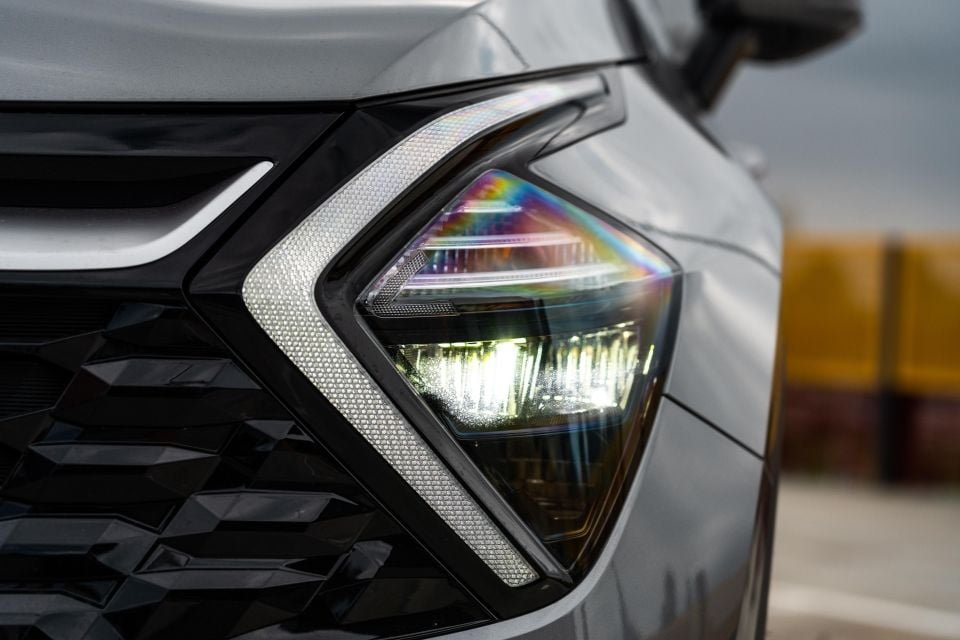

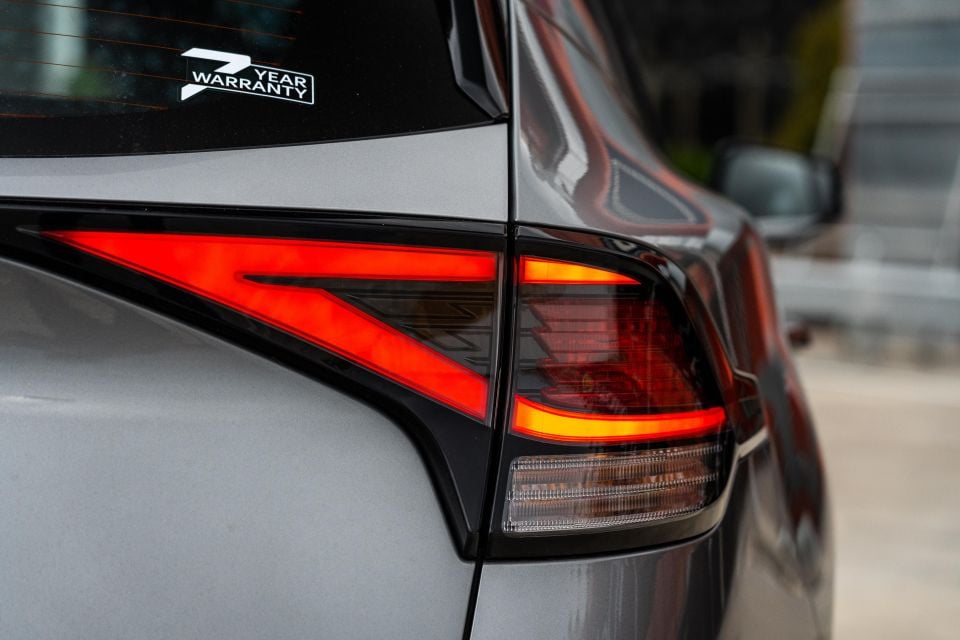
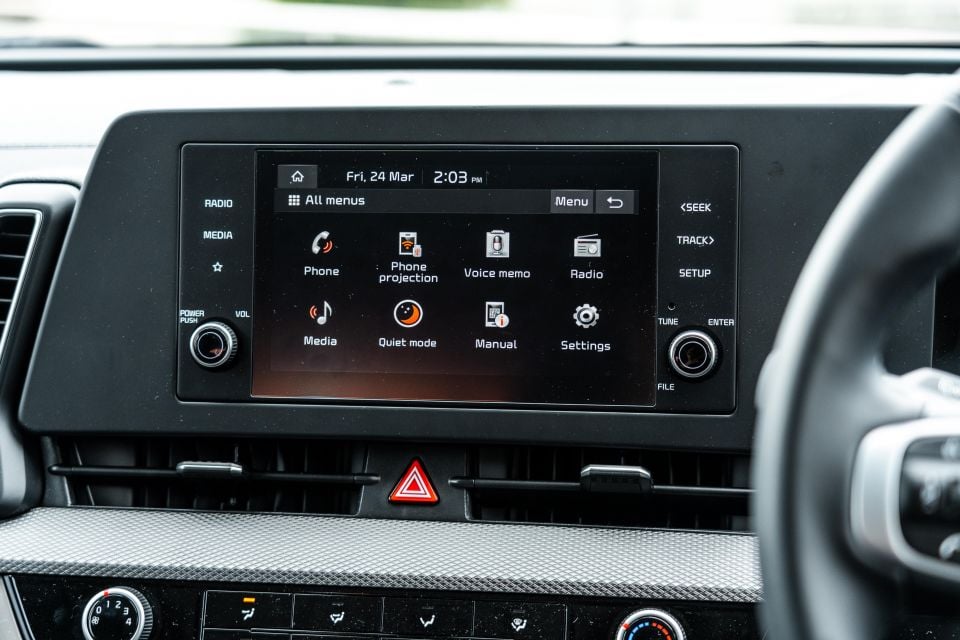
Sportage S highlights:
**not available for manual variants
The Kia Sportage wears a five-star ANCAP safety rating, based on tests by Euro NCAP in July 2022.
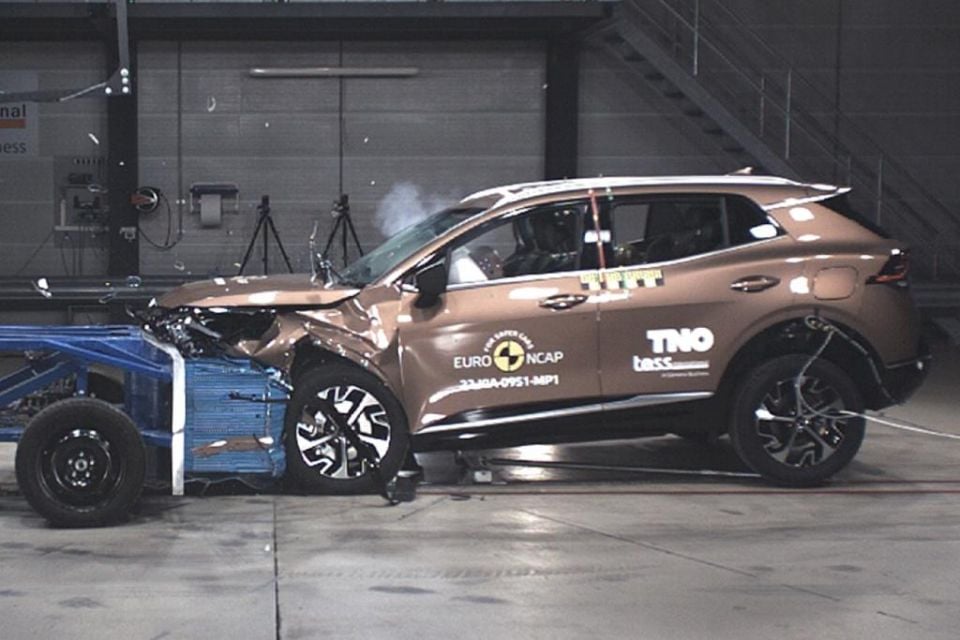
It scored 87 per cent for adult occupant protection, 87 per cent for child occupant protection, 66 per cent for vulnerable road user protection, and 74 per cent for safety assist.
Standard safety equipment includes:
Sportage GT-Line adds:
The Sportage is covered by Kia’s seven-year, unlimited-kilometre warranty, with capped-price servicing and roadside assistance for the same period.

Smartstream G2.0 and D2.0 models offer 12 month/15,000km intervals – whichever comes first – while the 1.6 T-GDI has shorted 10,000km gaps between visits. Worth noting if you do more annual miles.
The Sportage 2.0D will set you back just under $2500 over five years under Kia’s capped-price servicing schedule, which is on the pricier side when you consider the Hyundai Tucson with the same drivetrain asks for $1875 for maintenance over the same period if you pay upfront.
Sportage Smartstream D2.0 service pricing:
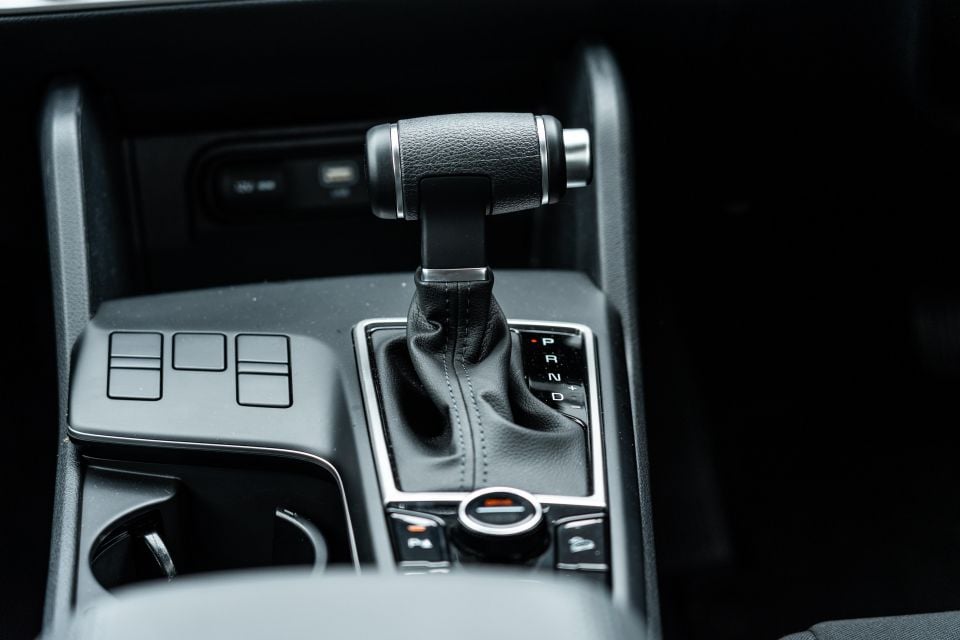
In terms of real-world fuel consumption, I was seeing low- to mid-6.0L/100km after a week of mixed driving, which is bang-on the brand’s claim. Considering there’s no idle stop/start fitted to local models, that’s pretty impressive.
Still, I’d like to see Kia start bringing in EU6 powertrains to further reduce consumption and emissions, particularly for the diesels as the AdBlue injection really helps to minimise harmful by-products of the fuel type – Kia is not alone in this either, most Japanese and Korean brands still bring in EU5 powertrains to Australia.
If you’re more of an urbanite but want the most efficient Sportage, next year Kia will be adding the Sportage Hybrid likely in SX and GT-Line specifications, which should be able to easily achieve 6.0L/100km in normal driving, even better if skewed to commutes around town.
Aussies love to go straight for the top of the tree, but there’s plenty of goodness in the Sportage’s roots.
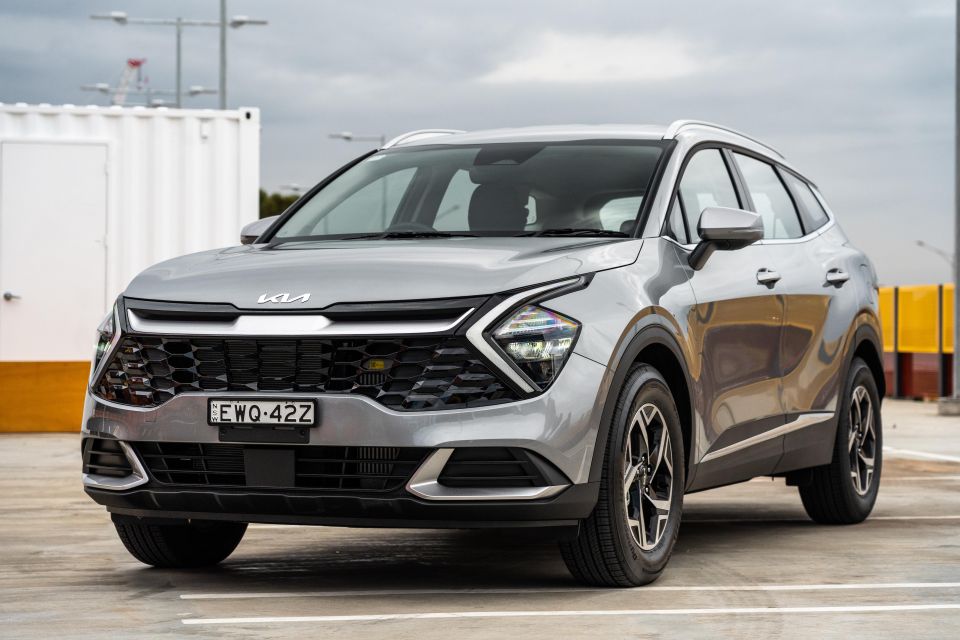
The base S specification with the high-spec 2.0-litre diesel AWD drivetrain gives you a crossover that covers all the bases in terms of safety and tech features, which is perfectly capable in all driving environments and offers a great balance between performance, efficiency and refinement.
For those wanting family transport that is safe and simple, the Sportage S won’t leave you wanting for much unless you want some of the niceties offered further up in the range. It’s otherwise got the key stuff covered, which plenty of rivals in the segment still don’t.
The level of space and practicality on offer is excellent, as is the long warranty. Service costs are a little high especially when the mechanically identical Hyundai Tucson is cheaper to service, but unless you’re willing to take a punt on a Chinese brand, rivals with a similar drivetrain are more expensive to buy.
While this Sportage S 2.0D AWD has pretty much everything you need for $40,000, the $2550 step up to the SX with the same drivetrain is very enticing, especially since it brings such desirable items like a larger, higher resolution 12.3-inch touchscreen with navigation, dual-zone climate control, front parking sensors and driver lumbar support.
Hybrids and EVs are making the headlines these days, but there’s still a lot to love about a good diesel still. Kia will add a Sportage Hybrid in 2024 if that’s more your jam. This will offer all the same great traits of the existing petrol and diesel models with the added benefit of an electrified drivetrain that saves fuel better in town, where most Sportage owners are more likely to spend the bulk of their time.

Click the images for the full gallery
MORE: Everything Kia Sportage
Where expert car reviews meet expert car buying – CarExpert gives you trusted advice, personalised service and real savings on your next new car.
James Wong is an automotive journalist and former PR consultant, recognised among Australia’s most prolific motoring writers.


William Stopford
15 Hours Ago


Matt Campbell
23 Hours Ago


William Stopford
2 Days Ago


Josh Nevett
4 Days Ago


CarExpert.com.au
5 Days Ago


Josh Nevett
6 Days Ago